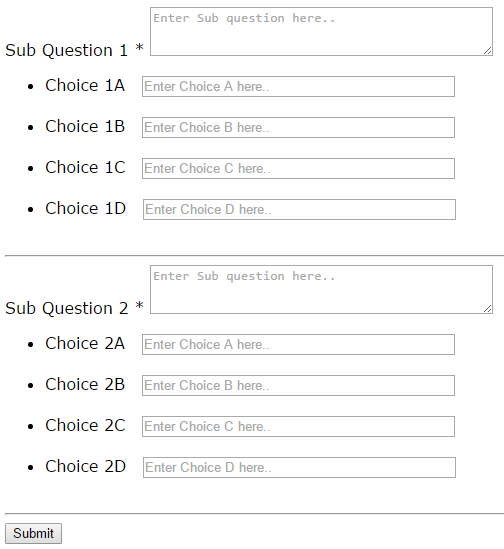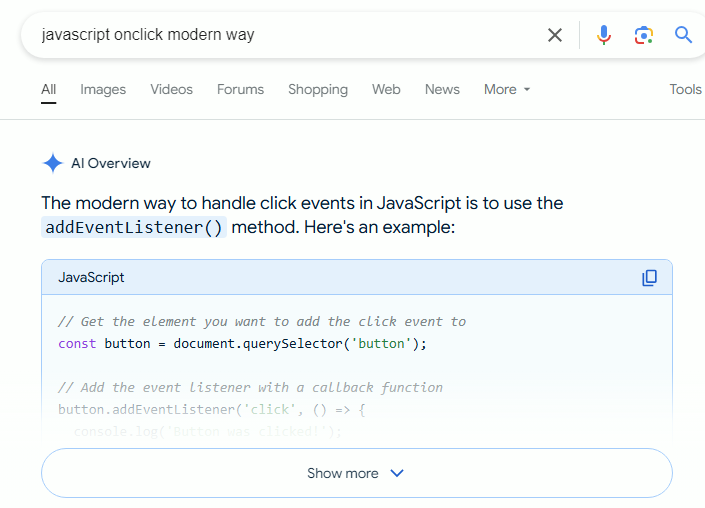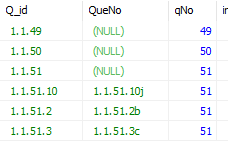Leaderboard
Popular Content
Showing content with the highest reputation since 08/01/2024 in all areas
-
One thing that might be helpful is to use the declare to wrap the block of code you want to have evaluated for statement processing. $count = 0; function statements() { global $count; $count++; echo "Statement Count: $count\n"; } register_tick_function('statements'); declare(ticks=5) { for ($x = 0; $x < 10; $x++) { echo "\$x = $x \n"; } } And you get: $x = 0 $x = 1 $x = 2 $x = 3 $x = 4 Statement Count: 1 $x = 5 $x = 6 $x = 7 $x = 8 $x = 9 Statement Count: 22 points
-
Highly recommend switching to a library like PHPMailer or SwiftMailer - they're both easier to use and more reliable than php's native mail function.2 points
-
the most common reason for a password_hash()/password_verify() to fail is because the database column is not long enough to hold the hashed value. another common reason are programming mistakes in the form/form processing code and a lack of server-side validation that results in the hash value not actually being from the password that was submitted in the registration code, or the value being used in the login code not being what you think it is. your post method form processing code should always trim the input data, mainly so that you can detect if all white-space characters were entered, then validate all inputs before using them.2 points
-
the file system path/filename must be to where the file is located on the disk, either using a relative path (relative to the file with the include/require starting in it) or an absolute path. a leading / refers to the root of the current disk, which is doubtful where that file is located, and which will be producing a php error about a non-existent path/file. you must get php to help you by reporting and displaying all the errors it detects. you can temporarily set php's error_reporting/display_errors in your code (you will want to remove the settings when you are done learning, developing, and debugging). you can add the following immediately after the first opening <?php tag in the main file - ini_set('display_errors', '1'); error_reporting(-1);2 points
-
I'd do something like this... <?php $data = [ '46.105.73.18:27015' => [ 'gq_address' => '46.105.73.18', 'gq_dedicated' => '', 'gq_gametype' => '', 'gq_hostname' => '', 'gq_joinlink' => 'steam://connect/46.105.73.18:27015/' , 'gq_mapname' => '', 'gq_maxplayers' => '', 'gq_mod' => '', 'gq_name' => 'Counter-Strike: Source' , 'gq_numplayers' => '', 'gq_online' => '', 'gq_password' => '', 'gq_port_client' => 27015 , 'gq_port_query' => 27015 , 'gq_protocol' => 'source' , 'gq_transport' => 'udp' , 'gq_type' => 'css' , 'players' => Array (), 'teams' => Array () ] ] ; $tdata = ''; foreach ($data as $k => $v) { $v = array_filter($v); // get rid of blank values $tdata .= "<table border='1'> <tr><th>Array key</th><th>" . join('</th><th>', array_keys($v)) . "</th></tr>\n"; // output headings $tdata .= "<tr><th class='rowth'>$k</th><td>" . join('</td><td>', array_values($v)) . "</td></tr> // output values </table>\n"; } ?> <html lang='en'> <head> <meta 'charset'='utf-8'> <title>Example</title> <style type='text/css'> table { border-collapse: collapse; margin-bottom: 10px; } th { background-color: #444; color: white; padding: 8px; } .rowth { background-color: #888; } td { padding: 8px; text-align: center; } </style> </head> <body> <?= $tdata ?> </body> </html> Giving ...2 points
-
First step to manually parsing HTML is to stop manually parsing HTML. Use DOM instead.2 points
-
After about 3 hours of waiting I killed the process as the SQL server never showed a status other than "idle". I think it hit a problem and got itself into an infinite loop doing nothing. To give myself some data to work with, I managed to extact the table structure , the first 3,400 and the last 600 records from the sql file. I could have done all of them but it (thankfully) uses multiple row inserts (1700 at a time) and it takes an age scrolling through the text to find each block's start and end then select the block. There are about 200 such blocks and each takes about 2.5 seconds to load the data - so the whole load should have taken 8-9 minutes. Enough of the excuses. I finally came up with a solution using the post table. The first part (WITH ...) creates a temporary table called "plast" which contains a row for each threadID with the latest date of all the posts for the thread. The main part of the query (SELECT ...) matches the threadid/latest date with the post table to find the matching post and also joins to the thread table to pick uo thread info. Finally, I limit the output to just those dates in the last 7 days. (Apologies for screwing up the text encoding along the way - eg "Jürgen Peters". It's only test data.) WITH plast AS ( SELECT threadID , MAX(time) as latest FROM wbb1_1_post GROUP BY threadID ) SELECT t.threadID , t.topic , p.userID , p.username , p.postid , FROM_UNIXTIME(p.time) AS time , FROM_UNIXTIME(plast.latest) AS latest FROM wbb1_1_post p JOIN wbb1_1_thread t ON p.threadID = t.threadID JOIN plast ON plast.threadid = p.threadid AND plast.latest = p.time WHERE FROM_UNIXTIME(p.time) > CURDATE() - INTERVAL 7 DAY ; +----------+----------------------------------------------------------------+--------+------------------+--------+---------------------+---------------------+ | threadID | topic | userID | username | postid | time | latest | +----------+----------------------------------------------------------------+--------+------------------+--------+---------------------+---------------------+ | 131549 | welche Spinne? --> eventuell Lepthyphantes sp. | 5455 | Manfred Zapf | 507256 | 2025-01-26 10:08:19 | 2025-01-26 10:08:19 | | 131698 | Baumwanze | 1397 | zobel | 507259 | 2025-01-26 12:48:43 | 2025-01-26 12:48:43 | | 56659 | Grüne Futterwanze? | 15196 | Christine | 507261 | 2025-01-26 14:57:09 | 2025-01-26 14:57:09 | | 131576 | Kleine schwarze Spinne --> Enoplognatha cf. thoracica | 15395 | Bernd 07 | 507263 | 2025-01-26 16:01:45 | 2025-01-26 16:01:45 | | 131307 | Amaurobius fenestralis? --> bestätigt | 15395 | Bernd 07 | 507264 | 2025-01-26 16:08:09 | 2025-01-26 16:08:09 | | 131701 | Unbekannte Schneckenart | 15395 | Bernd 07 | 507267 | 2025-01-26 16:43:50 | 2025-01-26 16:43:50 | | 131702 | Encyrtidae? | 11406 | JohnEs81 | 507268 | 2025-01-26 17:00:37 | 2025-01-26 17:00:37 | | 131700 | Welche Wanze ist das? --> Arocatus longiceps | 15395 | Bernd 07 | 507272 | 2025-01-26 17:36:02 | 2025-01-26 17:36:02 | | 131699 | Tegenaria --> nein sondern Amaurobius similis/fenestralis | 1999 | Klaus Fritz | 507274 | 2025-01-26 17:48:07 | 2025-01-26 17:48:07 | | 131683 | Grüne Larve -> Geometridae Art | 11406 | JohnEs81 | 507280 | 2025-01-26 20:41:49 | 2025-01-26 20:41:49 | | 131703 | eine Acericerus heydenii? | 1 | Jürgen Peters | 507282 | 2025-01-26 20:45:32 | 2025-01-26 20:45:32 | | 131687 | Zygina nivea? | 15392 | Sascha_N | 507286 | 2025-01-26 21:15:21 | 2025-01-26 21:15:21 | | 131686 | Welcher Schnellkäfer? --> Melanotus sp. | 15395 | Bernd 07 | 507287 | 2025-01-26 21:29:11 | 2025-01-26 21:29:11 | | 131693 | Lispocephala brachialis --> bestätigt | 15800 | Bernd Cogel | 507293 | 2025-01-26 22:06:16 | 2025-01-26 22:06:16 | | 131704 | Cantharis paradoxa? --> Cantharis sp., ein schwarzer, immerhin | 15335 | Simeon Indzhov | 507295 | 2025-01-26 22:29:15 | 2025-01-26 22:29:15 | | 131695 | Peyerimhoffina gracilis? | 15335 | Simeon Indzhov | 507296 | 2025-01-26 22:36:08 | 2025-01-26 22:36:08 | | 131705 | Phytoecia coerulescens? | 1 | Jürgen Peters | 507297 | 2025-01-26 22:52:48 | 2025-01-26 22:52:48 | +----------+----------------------------------------------------------------+--------+------------------+--------+---------------------+---------------------+ Are you planning on rebuilding the database?2 points
-
you are doing 'date-ination'. it's like pagination, but using dates. you should be using a get request to determine what will be displayed on the page. this is so that if someone finds a result they would like to return to or share, they can bookmark or share the URL and can return to the same result. the dates you pass in the URL should be a standard YYYY-MM-DD format. format the dates as 'l j M' only when you display them. you would default to the current monday if there is no get input. you would produce the previous/next links with the previous/next monday's date and include any existing get parameters so that if you add other search/filters, they will automatically get propagated in the URL between pages. example code - <?php date_default_timezone_set('America/Denver'); // default to the current monday if there is no get input if(!isset($_GET['fdw'])) { $dw = new DateTime('monday this week'); $fdw = $dw->format('Y-m-d'); } else { // you should validate that the get input is a properly formatted date - code left up to you $fdw = $_GET['fdw']; } // use $fdw in your code to produce the output $dw = new DateTime($fdw); echo $dw->format('l j M') . '<br>'; // get a copy of any existing get parameters $get = $_GET; // produce the previous link // calculate previous date $dw = new DateTime($fdw); $pw = $dw->modify('-1 week'); $pfdw = $pw->format('Y-m-d'); // set the fdw element $get['fdw'] = $pfdw; // build the query string part of the url $qs = http_build_query($get,'','&'); echo "<a href='?$qs'><button>< Previous Week</button></a>"; // produce the next link // calculate next date $dw = new DateTime($fdw); $nw = $dw->modify('+1 week'); $nfdw = $nw->format('Y-m-d'); // set the fdw element $get['fdw'] = $nfdw; // build the query string part of the url $qs = http_build_query($get,'','&'); echo "<a href='?$qs'><button>Next Week ></button></a>";2 points
-
It might work a little more cleanly in PHPStorm, but when I tried it in VS Code, I found it much more complicated to try to select text or read through code when the editor was injecting those things into the view. Maybe if they weren't inline, though I can't imagine how not, they might be nicer for me... But I'm also a proponent of the idea that you should be able to tell what the parameter is, be that through a variable name or an obvious literal value (or a constant...), and if you can't tell then you should do something about that. // this is obvious on what the parameters are password_verify($password, $hashedPassword) // this is not password_verify($value, $row[1])2 points
-
Judicious application of array key names can greatly increase the efficiency and simplicity of your code. Consider this simplified version of the questions/options form code <form method='post' > <?php for ($qno=1; $qno<=2; $qno++) { echo <<<HTML <label> Sub Question $qno <span class="req">*</span> <textarea cols="46" rows="3" name="Q[$qno][question]" placeholder="Enter Sub question here.."></textarea> </label> <ul> HTML; for ($opt='A'; $opt<='D'; $opt++) { echo <<<HTML <li>Choice $qno$opt (text) <input type='text' name="Q[$qno][opts][$opt]" placeholder="Enter Choice A here.." size='40'> </li><br><br>\n HTML; } echo "</ul><hr>\n"; } ?> <input type='submit'> </form> producing... When the form is submitted, the POST array is like this... Array ( [Q] => Array ( [1] => Array ( [question] => aaaaaaaaaaaaaaaaaaaaaaaaaaa [opts] => Array ( [A] => aa [B] => bb [C] => cc [D] => dd ) ) [2] => Array ( [question] => bbbbbbbbbbbbbbbbbbbbbbbbb [opts] => Array ( [A] => ww [B] => xx [C] => yy [D] => zz ) ) ) ) Now you can easily iterate through the array to write the questions/options to you database foreach ( $_POST['Q'] as $qno => $qdata ) { write $qno and $qdata['question'] to question table save last insert id as $qid foreach ( $qdata['opts'] as $ono => $choice ) { write $qid, $ono, $choice to choice table } } Job Done.2 points
-
the code for every page (http request) must enforce what the current user can do or see on that page. if you do what i wrote in one of your recent threads - the code performing the admin actions will find that the current user is either not logged in, doesn't exist, or no longer has a role that allows access to the code on that page and the user will be prevented from performing any action.1 point
-
the above line is missing any { }, so the only line of code that gets executed for an is_dir() is the - echo '<strong>'.$directory .'</strong> <br>'; all the rest of the lines get executed regardless of what $directory is. i recommend that you always format your code so that you can see when it is actually doing.1 point
-
"Revolution"? lol. It's another Whatever from the tech world. It's not the first fad used to pump up stock prices, and it won't be the last. The current state of glorified autocomplete systems AI contributes just about as much value to the world as The Blockchain does. You remember that whole thing? Wasn't that long ago when The Blockchain was being called a "revolution" too... The next Whatever will happen in a few weeks, or months, or years, and every publicly-traded company will jump on that as fast as they can too. (Make sure you're not still holding onto all of your NVDA when that happens.) And I'm sure that'll bring its own "revolution" too.1 point
-
Done this for many systems: 100% agree with Barand. I will go one step further and make this an "event" table where the system can insert rows for other events. Off the top of my head other events (in an event_type table or enum) would be a list like this: login logout bad password attempt change password reset password request etc. A simple table like this is common, has and has the benefit (with proper indexing) of allowing for the types of analysis and controls Barand listed. It also allows for mitigating brute force password attempts, as you can use this table to limit the number of login attempts within a given time period for a specific user, and lock the account after a certain number of attempts. Beyond the relationship to the User table (by Id) and a timestamp, you also typically want to store the IP address of the client. If it's mysql, the best way to do this (and natively support both IPv4 and IPv6) is to store the IP as VARBINARY(16) and use the INET6_ATON() and INET6_NTOA() functions to convert the IP when storing and retrieving. Small tables like this, with a clear design scale very well, as MySQL/MariaDB (using the InnoDB engine) is tuned to maximize Select & Insert concurrency. Often people will attempt to use a column or 2 in the user table, which they repeatedly update (ie. "last_login") which reduces concurrency, and is also less valuable than having a full history.1 point
-
Don't. PHP isn't a low-level language like C. You don't have to manage memory like that. PHP has some very smart internal logic and is perfectly capable of handling creating and destroying variables on your behalf. So let it do what it knows how to do.1 point
-
telling us that something doesn't work is pointless. we are not sitting next to you and didn't see what symptom or error you got that leads you to believe something didn't work. you must tell or show us what result you got and what the expected result should be. do you have php's error_reporting set to E_ALL and display_errors set to ON, preferably in the php.ini on your system, so that php will help you by reporting and displaying all the errors it detects? have you checked in the browser's developer tools, console tab for errors? you should use 'require' for things your code must have. require/include are not functions. the () around the path/filename do nothing and should be removed. $_GET['email'] is an input to your code. it may not exist. you need to use isset() to prevent errors when it doesn't exist and you must trim, then validate it before using it, when it does exist. the two session variables are also inputs to your code. they may not exist. you need to use isset() to prevent errors when they don't exist.1 point
-
Hi CBG, Logical switches do not work like spoken words and it is easy to misunderstand them. What you really want to check is that if any one of d,c,o is yes, then error. But PHP is obeying your instructions by stopping when anyone of them is No. You need to switch the OR to an AND and it will catch the one Yes that is not allowed: <?php $p = "Yes"; //yes is different than Yes $d = "No"; $c = "No"; $o = "No"; if ($p === "Yes" && $d !== "Yes" && $c !== "Yes" && $o !== "Yes") { echo "error"; exit; } echo 'no errors'; ?> which will display an error if all three (d,c,o) are No. Otherwise, the code will display no errors. but what are you doing when a lowercase y is used? yes instead of Yes. maybe you should also use lowercase and compare with strtolower().1 point
-
It can be solved by hosting provider. You can contact then to ask about MySQL and firewall problems.1 point
-
An "if() construct" often comes in useful at times like this.1 point
-
what this would look like using the method i posted above - <input type="text" maxlength="32" size="42" name= "<?=$Comment_Name?>" value="<?=$_SESSION["DE_Retain"] == 1 ? $_SESSION["DE_Comment"] : ''?>"> Max 32 Characters<br><br> likewise for the checkbox logic - Retain comment: <input type="checkbox" maxlength="1" size="1" name="Retain" <?=$_SESSION["DE_Retain"] == 1 ? 'checked' : ''?>> i'm pretty sure that checkboxes don't have maxlength or size attributes. if any of these variable may not exist, to prevent php errors, you need to use the null coalescing operator ?? to set default values. if you want to clear all the session data, you can use session_destroy();. if you only want to clear this 'form' data you are passing around, while keeping the current user logged in, you should store this data in a session array variable, such as $_SESSION['post']. you can then clear this data by just unsetting it - unset($_SESSION['post']);1 point
-
the php error you are getting is a follow-on error, because the query is failing, but there is no error handling for the query. the easiest way of adding error handling for all the mysqli statements that can fail - connection, query, exec, prepare, and execute, is to use exceptions for errors (this is the default setting now in php8+). to enabled exceptions for the mysqli extension, add the following line of code before the point where you make the database connection (or upgrade to php8) - mysqli_report(MYSQLI_REPORT_ERROR | MYSQLI_REPORT_STRICT); you should then be getting an uncaught exception error with the raw database error information in it about a non-groupby/non-aggerate column being referenced. the correct way of fixing this is to a) only select the columns you are using, and b) every column you are selecting needs to be either in the GROUP BY term or used in an aggerate function. there is a database server mode setting that control if this condition produces a query error (the current setting) or if it is just a warning. you may or may not have access to this database mode setting.1 point
-
First an editorial comment: Please do not take screen shots of code for your questions. We can't use that in our replies or help. We have a code block for a reason. You can easily copy/paste snippets of relative code into the code block, and that makes it possible for us to make edits based on the original code. Nobody here likes having to re-type parts of your code. Paths in your html are relative to the document root. The document root is a function of the web server configuration for the server or vhost you have configured. The types of things you can refer to in an html script are only things that the server understands to have an associated URL. In other words, they are things that you could use a url to access directly from your website. PHP works entirely with files, and file system paths on your workstation. Using PHP code to open include/require files always requires a file system path. When you include a file, the "working directory" for PHP is the path/location in the server file system where the script exists. So to include a php script from another php script you have 2 options: Provide the fully qualified path to the script. Because this path is operating system dependent, you typically don't want to do this as it requires you to add configuration in a file or even edit your source code purely because you moved servers. A Relative Path This is relative, again to the directory where the script that is including this code is. Relative paths can utilize 2 "special files": "." is the current directory. ".." is the parent directory. We don't know what the file system layout is for your project, so we can only guess at the correct path relative to the index.php? or whatever file it is that you are trying to do this php include in is named. If this directory has a sub-directory named "page" and you have put the site-header.php script into that directory, then the relative path you want to use will be: include("page/site-header.php"); This is how you specify a subdirectory path relatively. If you include a leading "/" that is considered the "root" directory of the filesystem. One other thing you might want to do is change include to require_once(). With a require_once() the script will actually error out rather than continue to run along without regard to the fact that your include failed.1 point
-
the attached code displays the menu, but has nothing to do with adding items to an order (cart), entering the customer information, or submitting/saving that information as an order. some points about the posted code, most of which will greatly simplify it (eliminating more than half of the typing) - use 'require' for things your code must have. don't prepare and execute a query that doesn't have any dynamic value being supplied to it. just use the ->query() method. the settings don't need elseif() logic, just if(), because the option_name can only be one value at any time. Don't Repeat Yourself (DRY.) there are only a few small things different between the corresponding if/else code blocks. the conditional logic should only setup the values for the different things in variables, then simply output them in one instance of the code. don't run queries inside of loops. use a single LEFT JOIN query to get the menu categories and menu items all at once. when you fetch the data, index/pivot it using the category id as the main array index. you can then simply loop over the data using two nested foreach(){} loops to produce the output. don't create unused variables/code. when embedding a php echo statement in html markup, use php's short-open-echo tag <?= and you can leave out the closing ; right before a closing ?> tag, for example - <?=$source?> SELECT queries that can return more than one row need an ORDER BY ... term to insure that the rows are in an expected order.1 point
-
here's an example for the fields you have shown in this thread - <?php // define the fields // you would add other things to this definition, such as validation rules and processing rules $fields["it_c"] = ['label'=>'Whatever it_c is','type'=>'numeric']; $fields["it_h"] = ['label'=>'Whatever it_h is','type'=>'numeric']; $fields["ot_c"] = ['label'=>'Whatever ot_c is','type'=>'numeric']; $fields["ot_h"] = ['label'=>'Whatever ot_h is','type'=>'numeric']; // add entires for all the form fields... // examine the submitted data echo '<pre>'; print_r($_POST); echo '</pre>'; ?> <?php // produce the form ?> <form method='post'> <input type='submit'><br> <?php foreach($fields as $field=>$arr) { switch($arr['type']) { case 'numeric': echo "<label>{$arr['label']}: <input name='$field' type='text' class='numeric'></label><br>"; break; // code for other types... } } ?> <input type='submit'> </form>1 point
-
this doesn't exist at the point when the ajax request is made, because they are two different http(s) requests. that's because ALL the code in index.php has already been executed during the initial http(s) request for index.php, by the time the ajax request occurs. for the initial case when the session variable doesn't exist, after you output the javascript code, the php code needs to exit/die without doing anything else (it currently runs to completion.) the ajax request needs to be to index.php, instead of screenDetect.php. the code will then set the session variable and it will be available when the rest of the code in index.php runs.1 point
-
Hi Gizmola, very helpful post. I've read about this topic for quite some time today and it is very fascinating to me. I should've explored sql many years ago but atleast i'm trying to catch up now. I have learned alot from Barand but i never implemented it with my own code to gain experience. I am learning alot today and your notes are also very helpful. I see how it is working now and it is quite clever 🙂 Thank you for taking time to educate me on this subject. I appreciate your expertise. I appreciate Barand's expertise always, although he may not know it. I hope that you have a pleasant evening and i'll keep experimenting with this concept to gain more experience with it.1 point
-
Hi everyone! My name is Jerry, and I’m new to the PHP Freaks community. I’m just starting to learn more about PHP and web development, and I’m excited to be part of this group. I’m here to improve my coding skills, learn best practices, and hopefully contribute to discussions as I grow. If you have any advice for a beginner or resources you recommend, I’d love to hear about them! Looking forward to connecting with you all and learning more about PHP. Best regards, Jerry1 point
-
Earlier in this thread you said that this ... +----+-----------+-----------+ | id | slug | tag_check | +----+-----------+-----------+ | 1 | hugh-jass | 1 | | 2 | hugh-jass | 2 | +----+-----------+-----------+ ... was acceptable. Your "solution" would not permit this. Secondly, you are using a "dependent subquery" which means for every record inserted you must query all the existing lookig for a duplicate. This can be extremely slow and should be avoided when writing queries. Changing your unique key to ... UNIQUE INDEX `unq_name` (`name`) USING BTREE, ... and using this query would have same result ... INSERT IGNORE into wp_terms (name,slug) SELECT concat(nameFirst,' ',nameLast) , lower(concat(nameFirst,'-',nameLast)) FROM a_players ;1 point
-
Can you put your code in a code block in the future? Reading/looking at double spaced code without proper indentation or color syntax highlighting wastes everyone's time and effort and greatly decreases the final results. Notice @Moorcam helpful reply to you where he put an offending line into a proper block where the issue is easy to identify.1 point
-
the only user data you should store in a session variable upon login should be the user id, to identify WHO the logged in user is. this will either be set or it won't be. you should query on each page request to get any other user data, such as a username, permissions, or role. this is so that any changes made to this other user data takes effect on the very next page request. this will allow you to promote or demote a user without requiring them to logout and back in for the change to take effect. do you really want a situation where you have demoted or banned a user and they can still access a page because their session data says they can? i recommend that you simplify the logic and separate the login test from the user role test. also, to test if a variable is in a set of values, define an array of the permitted values and use in_array() to perform the test. using these suggestions, the logic would become - $page_roles = ['Member','Secretary']; // roles permitted for the current page $user_role = 'Guest'; // default value for a non-logged in user // is there a logged in user if(isset($_SESSION['user_id'])) { // query here to get any other user data, such as the user role, and store it in a regular variable // fake a value $user_role = 'Member'; // $user_role = 'Secretary'; // $user_role = 'Other'; } // logic to determine if the current user can access something on this page if(in_array($user_role,$page_roles)) { // access permitted echo 'permitted'; } // logic to determine if the current user cannot access something on this page if(!in_array($user_role,$page_roles)) { // access denied echo 'denied'; }1 point
-
I've hidden your, let's say, unconstructive post. Since I'm an actual developer who wants to see other people learn and grow so they can become actual developers, I don't tell people something that they can copy and paste into their code. I give them information and hope that they're willing to put in the time and effort into understanding what it is they're doing. So thank you for your feedback but I'm going to continue calling out instances of people writing 1990s-era Javascript without understanding what they're doing and why it isn't working. After all, there's a very simple and fundamental principle in play right here: if you're going to work with something, the least you can do is try to learn more about it. If you want something to tell you the answer so that you can copy and paste it into your code then you already know about ChatGPT, but did you also know you can do things like throw terms like "javascript onclick modern way" into Google and it'll spit out some AI nonsense of its own that is actually occasionally useful? I tend to assume people will invest time into a thread so I tend to avoid writing long knowledge-dump replies - because it's too much information at once, and also becomes sometimes it turns out to be a waste of my time - but had this thread continued, maybe it could have gone like this: Q: Okay, so I understand that onclick is just executing code, but what do you mean it isn't returning a value? The return statement is right there. A: Yes, the return statement for ConfirmDelete, but there's no return statement for the onclick itself. Like I said, it is basically a function even though it's written as an attribute in the HTML, and it's that function that needs to return true/false. Q: So is that the modern way? Returning from the onclick? A: No, the modern way is to not use any of those on* attributes and instead attach events through Javascript. As in, when the page loads you run a bit of Javascript that attaches events to whatever elements it needs to using addEventListener. Q: I read up on addEventListener and switched to using it, but now when I click the button, I get the confirmation and it still submits the form. [Insert code here.] A: That's because event handlers done through addEventListener work a little differently. You can't just return false to stop the event - the code needs to be a little more sophisticated in that it explicitly says "stop the event"... except you don't actually need that. There's another way that (IMO) is simpler to work with. Q: What's the other way? A: Instead of making the button be a submit button, make it be a regular button. And instead of making the event handler stop the form from submitting, it directly makes the form submit. Meaning instead of "if not confirmed then stop" it's now "if confirmed then submit". Which probably makes more sense from a human-being angle: you typically think about these things in a proactive way like "if I click the button then I want to get a popup asking me if I'm sure I want to submit the form" (which the new code would say) and not the reactive way of "if I click the button then submit the form, but only first after asking the user if they want to" (which the old code says). It's a subtle distinction, and admittedly not one that's relevant all the time. Q: I don't follow. What would I do differently? A: Change the button to a regular "button"-type button, keep with the addEventListener, but change your popup thing to be "if (confirmed) { submit form }". [Insert code here.] Q: That sounds complicated. Why should I do all this when I could have just stayed with onclick and returning true/false? A: Because if you ever want something fancier than the confirmation popup you have now, the onclick+return pattern simply won't work. You can only do that when the code can make an immediate determination of whether or not to continue with submitting the form. If the confirmation was any sort of Web 2.0-style modal then it couldn't return immediately and you'd be forced into this alternate scheme. You might as well get used to the pattern now so it'll be easier to remember when you need it. Besides, it's not like it's a huge amount of work, and the additional work compared to onclick+return isn't wasted because you're improving the quality of the code as you go. And quality of code directly translates into quality of life.1 point
-
PHP uses the form element's name attribute to name the _POST or _GET variable. Your select element is named 'std', not 'Location_ID'.1 point
-
So you want something like this: foreach ($tokenArr as $val) { //... current code // bottom of foreach loop if ($errMess !== '') { break; } }1 point
-
You only need one query. For example TABLE : product +----+-------------+--------------+--------+ | id | productName | category | status | +----+-------------+--------------+--------+ | 1 | Room 1 | Guestroom | Active | | 2 | Room 2 | Guestroom | Active | | 3 | Room 3 | Guestroom | Active | | 4 | Room 4 | Guestroom | Active | | 5 | Function 1 | Functionroom | NULL | +----+-------------+--------------+--------+ code $sql = "SELECT SUM(status='Pending')as pending , SUM(status='Active') as active FROM product"; $result = mysqli_query($con, $sql); $row = mysqli_fetch_assoc($result); echo "Pending : <input type=\"button\" class=\"button\" value=\"{$row['pending']}\"> Active : <input type=\"button\" class=\"button\" value=\"{$row['active']}\"> "; output1 point
-
I'm not well versed in using cURL, but based on what you provided previously your call to the URL you are using is returning the response: 301 error "Permanently Moved" But, you expect to be getting the JSON encoded output for the $allowed_domains array you are creating. I would assume you have tested the url in a browser and verified you are seeing the JSON content? If not, start there. If the content is correct when access via a browser then my best guess is that the web server maybe has some logic to detect programmatic access to pages and is blocking it. I'm pretty sure I've seen something like that before. But your issue has noting to do with the error you first reported. You need to figure out why your cURL request is not retrieving the JSON content you think it should be returning. Although, this is a good opportunity to add additional error handling to your code to cover a scenario where the cURL request doesn't fail, but does not return contents you expect.1 point
-
Misunderstood. Frameworks are a bunch of code that other people wrote to do stuff. Using them saves you the time of having to write your own bunch of code to do stuff. They do so much stuff that the intention is you take what they provide as a foundation and then add what you want. There's also libraries, which are a bunch of code that other people wrote to do stuff that saves you the time of having to write your own code to do stuff, but they're much smaller in scope than frameworks. They're basically about solving small individual problems, so using libraries means you don't have to solve those same problems yourself and you can focus on more important issues. There is overlap between frameworks and libraries. The distinction is in how they get used: are you taking a bunch of stuff and adding more, or are you using stuff to create other separate stuff? VS Code and Dreamweaver (if anyone still uses that) are "integrated development environments", but everybody just calls them IDEs. IDEs are glorified text editors, in that they let you type stuff into a text file just like any simple text editor does, but IDEs also have tons of features dedicated to dealing with code and so are much nicer to use than text editors. Like they can be aware of language syntax nuances and tell you when you wrote something wrong, while text editors might be able to do a little bit of that but would care more about checking your spelling. I don't like "template" as a metaphor. A template is about taking something and supplying a few bits here and there and you're done. You go to some blog creator website (coughwordpress) and they'll give you a template for a site: you set a name, colors, images, whatever, but all you're doing is customizing the same basic thing that everybody else is using. This forum is basically a template because we installed Invision Power Board and customized it a bunch. A framework is about you having a starting point for actually building something - not just customizing. You write code to do things, you implement features, you make decisions about how things work, and so on. Making a complicated website involves many different things, and frameworks have a lot of that designed for you so you don't have to make it all yourself. Where are you seeing "controls"? That typically means things like text boxes and buttons and links, like right now I'm typing into a "textarea" control that has a bunch of formatting button controls at the top and a "submit" button control below it. But people don't normally use the word "control" much these days. I think maybe you shouldn't worry much about what a control is. It's such a generic term that it doesn't really say much. "Text box" and "button" and "link" are specific types of controls, and talking about those is much easier (but also kinda off-topic from what we're talking about now).1 point
-
Each login is still dealing with a user of some role. You shouldn't be concerned with role at login, you should be concerned with role at display time. In other words everybody logs in via the same form and when the user accesses a page, what's displayed is dependent upon the role. So if there's an admin section of the menu, that's only shown to admins. And if there are pages that only mods or admin supposed to see, the user role is checked and the redirect happens at that point instead of at the login.1 point
-
Why the Freckle didn't you post the code that actually used to get the results you are complaining about. Once I got the data loaded, your query wouldn't even run without corrections to column names. Anyway - the answer to your question... They are in the wrong order because you order by your generated qNo column. I'd give up on that method. If you are using MariaDB, you can ORDER BY NATURAL_SORT_KEY(Q_id) If MySQL (which doesn't have that function), use FetchAll() to get an array of your results then natsort($results) use a custom sort which does a strnatcmp() on the Q_id column $res = $pdo->query(" ... "); $result = $res->FetchAll(); usort($results, fn($a,$b)=>strnatcmp($a['Q_id'], $b['Q_id'])); (Using sort($results) would have sorted using the values of the first column in each row - I assumed natsort() would do the same (silly me) )1 point
-
There is an example near the end of the documentation for last_insert_id. Something like this I am guessing. $sql = " UPDATE $table SET item=?, id=LAST_INSERT_ID(id) WHERE id<10 ORDER BY id ASC LIMIT 1; "; //and then $last_id = mysqli_insert_id($conn); echo "Last inserted ID is: " . $last_id;1 point
-
1 point
-
It's better to paste the (relevant) code, and/or screenshots for stuff that's visual, directly into your post: most people here try to keep safe and so won't download random files from strangers on the internet. That stuff you included there is XML, and it's easy to read with PHP. But you're talking about margins and line breaks, which isn't actually PHP, though the line between what is and isn't PHP does get a little blurry sometimes. Can you give a more detailed description about what you're doing, what you've written so far, what happens when you run it, and what you were expecting it to do instead? Remembering to post code as you go, of course.1 point
-
My post should not have been marked as the solution. requinix should be marked as such. He gave you the answer. You just didn't look completely at the link he provided. Glad you got it sorted though.1 point
-
where is this data coming from and how do you know which values belong in which group?1 point
-
XHTML was a thing quite some time ago. Modern HTML has the semantic benefits that XHTML (as I understood it at the time) claimed to have, while not being as strict in terms of some of the usage. You'll also find modern HTML referred to as HTML5, though honestly these days I'm not sure if the version number even means anything anymore.1 point
-
XHTML? No, this is just regular HTML... <header> elements are HTML 5 replacements to writing stuff like <div class="header">, which means things like browsers and screen readers can more accurately understand the nature of a page. That means they're geared towards content, not metadata. Which means they belong in the document body. https://developer.mozilla.org/en-US/docs/Web/HTML/Element/header1 point
-
mysqli_fetch_array() does not return the number of rows To do that you would need to remove and authorized ='1' and add "authorized" to the selected columns. Then check if $num['authorized'] == 1 (or not).1 point
-
1 point
-
no matter how large you set the max_post_size setting, someone can upload a file that is larger. the size of the file someone tries to upload is out of your control. your code must test for this condition and handle it. also, by increasing the setting beyond a reasonable size, it will allow hackers to flood your server with huge uploaded files, consuming all the available processing and memory on the server, allowing a denial of service (DoS) attack.1 point
-
Example... DATA mysql> select * from worked_hours; +----+---------+---------------------+---------------------+ | id | user_id | start_time | finish_time | +----+---------+---------------------+---------------------+ | 1 | 1 | 2024-06-17 09:00:00 | 2024-06-17 17:26:00 | | 2 | 1 | 2024-06-18 09:00:00 | 2024-06-18 17:31:00 | | 3 | 1 | 2024-06-19 09:00:00 | 2024-06-19 17:12:00 | | 4 | 1 | 2024-06-20 09:00:00 | 2024-06-20 17:40:00 | | 5 | 1 | 2024-06-21 09:00:00 | 2024-06-21 17:01:00 | | 6 | 1 | 2024-06-22 09:00:00 | 2024-06-22 17:36:00 | | 7 | 1 | 2024-06-23 09:00:00 | 2024-06-23 17:47:00 | | 8 | 1 | 2024-06-24 09:00:00 | 2024-06-24 17:19:00 | | 9 | 2 | 2024-06-17 09:00:00 | 2024-06-17 17:20:00 | | 10 | 2 | 2024-06-18 09:00:00 | 2024-06-18 17:43:00 | | 11 | 2 | 2024-06-19 09:00:00 | 2024-06-19 17:45:00 | | 12 | 2 | 2024-06-20 09:00:00 | 2024-06-20 17:35:00 | | 13 | 2 | 2024-06-21 09:00:00 | 2024-06-21 17:26:00 | | 14 | 2 | 2024-06-22 09:00:00 | 2024-06-22 17:14:00 | | 15 | 2 | 2024-06-23 09:00:00 | 2024-06-23 17:55:00 | | 16 | 2 | 2024-06-24 09:00:00 | 2024-06-24 17:15:00 | | 17 | 3 | 2024-06-17 09:00:00 | 2024-06-17 17:40:00 | | 18 | 3 | 2024-06-18 09:00:00 | 2024-06-18 17:15:00 | | 19 | 3 | 2024-06-19 09:00:00 | 2024-06-19 17:35:00 | | 20 | 3 | 2024-06-20 09:00:00 | 2024-06-20 17:26:00 | | 21 | 3 | 2024-06-21 09:00:00 | 2024-06-21 17:38:00 | | 22 | 3 | 2024-06-22 09:00:00 | 2024-06-22 17:41:00 | | 23 | 3 | 2024-06-23 09:00:00 | 2024-06-23 17:00:00 | | 24 | 3 | 2024-06-24 09:00:00 | 2024-06-24 17:04:00 | +----+---------+---------------------+---------------------+ QUERY WITH hrs as ( SELECT user_id , DAYNAME(start_time) as day , TIMESTAMPDIFF(MINUTE, start_time, finish_time)-30 as mins , SUM(TIMESTAMPDIFF(MINUTE, start_time, finish_time)-30) over w1 as cum , SUM(TIMESTAMPDIFF(MINUTE, start_time, finish_time)-30) over w1 - TIMESTAMPDIFF(MINUTE, start_time, finish_time)-30 <= 1500 as include FROM worked_hours WINDOW w1 as (PARTITION BY user_id ORDER BY start_time) ) SELECT user_id , day , mins , cum FROM hrs WHERE include; RESULTS1 point
This leaderboard is set to New York/GMT-04:00














